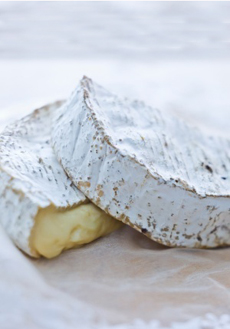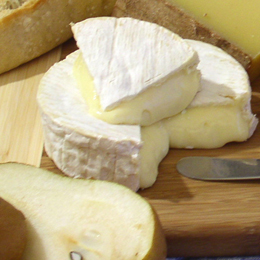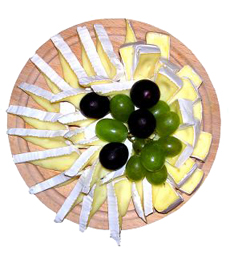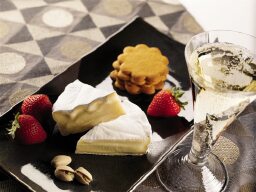 Brie and Camembert are ripe when the rind starts to mottle and the paste starts to bulge. Photo by Maribee | IST. Brie and Camembert are ripe when the rind starts to mottle and the paste starts to bulge. Photo by Maribee | IST.
|
STEPHANIE ZONIS focuses on good foods and the people who produce them.
|
|
May 2007
Last Updated November 2011
|
 |
Brie Vs. Camembert
Page 3: When Is A Brie Or Camembert Ripe & Ready
To Eat
This is Page 3 of a three-page article. Click on the black links below to visit other pages.
Selecting A Cheese
Now that you have some background about these cheeses, let’s discuss selection.
Americans are accustomed to enjoying an unripe brie paste—one that can be cut into neat wedges that keep their shape. That’s what’s available at most supermarkets, and we just don’t know better.
Many Americans have the wrong idea about the texture of the paste when cheeses are ripe, especially where double-crème and triple-crème cheeses are concerned.
Real Brie should “bulge” or flow minimally, but not run. A truly runny interior (the cheese runs out of the rind and onto the plate) often indicates that the cheese is probably overripe.
Eating a ripe Brie or Camembert is a sublime experience. Supposing you’re lucky enough to have a good cheese retailer nearby:
How do you tell a ripe Brie or Camembert from one that’s under- or overripe?
- Mottled Rind. Gilles of Artisanal Premium Cheese explains that a very young Brie or Camembert will have a rind that is “pristinely white.” Such cheeses are liable to be chalky-textured and solid inside—in a word, underripe. This is not what you want. You are looking for that “pristinely white” rind to become mottled with a coloring that is variously described as reddish, brownish, or yellowish (see photo at the top of page). But there shouldn’t be too many streaks of color. If the rind is “ugly,” says Jenkins, the cheese is past its prime.
- Some sources, such as The Camembert Web Pages, state that the rind should look like “a thin white down” and may be covered with very small red dots. But Gilles urges caution in this visual predictor, as appearance depends on origin. He says that an industrially-produced Brie or Camembert might purposely have a perfectly white rind at maturation—created in the factory—because such a rind appeals to consumers who have not been educated about cheese.
- Paste. The interior, or paste, of both Brie and Camembert should be straw-colored.
- Smell. There are also smell and touch tests. Gilles tells me that a typical trick in France for Camembert is to turn the wooden box in which it comes upside down and remove the bottom. Take a sniff of the cheese. If it smells good, that’s a promising sign. If there is even the slightest odor of ammonia, don’t buy it! The cheese is overripe.
- You can still eat the cheese safely, but it will taste overripe and/or ammoniated.
|
|

A ripe, bulging Camembert. Photo courtesy iGourmet. |
- Touch. For a touch test, Jenkins suggests that you make a loose fist. Now, gently press the fleshy area between index finger and thumb, which he says “should yield to the touch like bread dough.” This, he asserts, is the feel of a perfectly ripe Brie or Camembert.
Ask questions. By all means taste the cheese—any reputable cheese store has a counter person who will cut you a bit to taste and smell.
And don’t be afraid to go elsewhere if you need to. You deserve the best in cheese, most specially with great classics like Brie and Camembert.
Enjoying Your Cheese
The Life Span Of Your Cheese: Short!
Once a wheel of Brie or Camembert is cut, most sources agree that the cheese won’t age any further.
Brie and Camembert are highly perishable, especially once they’re cut into. Store them in the refrigerator, but take them out a half hour before you need them. You want to serve them with the chill off, as both will have much more flavor and better texture.
Neither cheese is a long “keeper,” even with refrigeration. Gilles of Artisanal believes that a perfectly ripe, raw milk Brie or Camembert may have a life span of only two or three days. Even the pasteurized examples of these cheeses need to be consumed with some speed.
Serving Brie & Camembert
Bloomy rind cheeses are served with the rind intact. The rind is considered one of the pleasures of the cheese.
- The wheel should be cut like a cake, in wedges.
- When serving a large wheel of brie for guests, cut the cheese in concentric circles to achieve small rectangular slices. Cut an outer circle first; when that has been consumed, cut the next circle.
- Dip the cheese knife into hot water, so the cheese won't stick.
|
|

Slices from a large wheel of Brie. Photo by Michal Zacharzewski | SXC. |
Wine Pairings
If you like to pair your cheeses with wine, Brie and Camembert are traditionally served with reds.
- Steven Jenkins believes that Brie calls for a “big” red wine but prefers to match Camembert with a “Gamay or Pinot Noir.”
- Other sources are less specific, claiming that either cheese is a fine partner to almost any red, including Cabernets or Zinfandels.
- For more festive occasions, I’ve seen Camembert matched with a good Champagne.
|
|

Brie and Champagne: a delicious combination. Photo courtesy Wisconsin Milk Marketing Board. |
Head To France Although I’d like to suggest a field trip to France for any of you interested in discovering more about genuine Brie and Camembert, I understand that budgetary and time constraints may be problematic in such an endeavor.
In a case like this, a knowledgeable cheese retailer can truly be your best guide. Given that real Camembert is unavailable in the U.S. and that the pasteurized substitutes are more bland, someone with experience in cheese might be able to suggest a tastier alternative.
Go To The Article Index Above
Sources:
Lifestyle Direct, Inc. All rights reserved. Images are the copyright of their respective owners.

|




